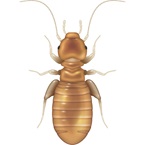Characteristics:
Forewings hard and leathery, meeting along mid-line of dorsal surface; hind- wings membranous, sometimes lacking; biting mouthparts; well- developed thorax; complete metamorphosis with egg, larval, pupal and adult stages. Densely covered with hairs or scales; 5–11 segmented antennae with distinct club; 5-segmented tarsi.
Species characteristics:
Hide Beetle (Leather Beetle) (Dermestes maculatus)- Adults, 5.5 -10 mm long; body, oval-shaped and densely covered with round scale-like hairs
- Thorax with patches of white hairs on the sides
- Elytra: uniformly coloured brown/black with an even scattering of white hairs
- Underside predominantly white
- Inner apex of each elytron produced backwards into a fine point
Larder Beetle (Bacon Beetle) (Dermestes lardarius)
- Adults, 7-9 mm long, body, oval-shaped and densely covered with round scale-like hairs
- Broad light band crosses elytra, with three black spots on each side
- Fine yellow underside
Areas where found:
The Dermestes beetles are typically associated with materials with a high protein content, for example hides, skins, feathers, bones, dried meat, fish meal and dog biscuits. They are scavengers associated in nature with carcasses and bird’s nests but can be encountered and may be widespread in manufacturing and storage premises handling animal products, intensive poultry units, piggeries and domestic premises. The Hide beetle is more commonly encountered in poultry houses
than the Larder beetle. Feathers, carcasses, spilt food, droppings and other insects in the poultry manure can all provide a source of food for the beetles. Where the sources of infestations are not immediately obvious e.g. domestic or catering premises, attention should be paid to food stores and spillage, or the presence of dead rodents, birds, fur and feathers in attics, under floor spaces etc.
Large populations can be encountered, especially where hygiene is poor. Heavily infested poultry manure may be spread onto fields and lead to the infestation of nearby properties. Hairs dislodged from the larvae may lead to skin irritation or conjunctivitis in people exposed to the insects. They play only a very minor role in disease transmission, although may act as mechanical vectors of anthrax. Adults and larvae require a high protein diet and the beetles can be serious pests in hide warehouses, tanneries, milk processing plants and other premises where animal products are handled. In poultry units the beetles can feed on feathers, carcasses, spilt food, droppings and other insects. Different species exhibit different food preferences, the Hide beetle preferring hides and skins whilst the Larder beetle exhibits a preference for meats, cheese etc. Particular damage is caused as the mature larvae excavate chambers in which to pupate. They usually move away from the foodstuff in which they have developed in order to avoid being eaten by other larvae whilst they are inactive. This migration encourages cross-contamination
between goods, packaging etc. Materials, which can be damaged, include soft sapwood, plywood, cork, polystyrene insulation and fibreglass wadding. Round holes approximately 4 mm in diameter are evidence of infestations and the burrows may extend up to 300 mm. Heavy infestations may result in the structural weakening
of wooden pillars, catwalks etc. Plastic water pipes and plastic-covered electric cables can be damaged. Packaging e.g. egg trays may also be damaged. Plaster, lead and tin may be excavated, but not zinc or aluminium. Adult beetles are also occasionally implicated causing this damage.
Lifecycle:
The females lay up to 800 eggs on a foodstuff suitable for larval development. They are white, 2 mm long and often laid in the crevices of commodities. The larvae hatch in about a week. They are dark brown banded, hairy and feed on almost any dry or decomposing animal material and even, occasionally, vegetable matter. They are very active, and will avoid light, frequently boring into commodities to do so. If disturbed they will curl up and feign death. There are typically 5–8 larval stages and the full grown larva is 10-15 mm long. Larvae usually mature in 1–2 months. They then pupate deep inside the infested commodity or leave the foodstuff and excavate holes in hard, inedible materials in which to pupate. Pupation usually takes place inside the last larval skin. The full life cycle, egg to adult typically takes 1–3 months depending upon conditions but may extend beyond a year if conditions are unfavourable. They will not breed below 15°C.
Control:
Assessment of infestations
The first step in control is to trace the source of infestation. This is usually obvious although in some premises it may be obscure and found to be associated with a dead animal that has passed unnoticed or an old bird's nest.
a) Hygiene/management
All sources of infestation should be removed and disposed of, taking care not to spread the infestation. Routine surveillance and regular cleaning are important.
Metal proofing strips provide physical barriers that can be built into structures to restrict migrating larvae reaching pupation sites in the fabric of buildings.
b) Insecticidal control
Thorough surface spray treatments (see recommended products) with residual activity are vital where infestations are extensive. Poultry units should be treated when they are empty and when infestations become unacceptable. Barrier treatments can be applied to prevent migrating larvae reaching pupation sites. The treatment of
infested manure is of limited value and may kill beneficial insects e.g. Carcinops pumilio.
_____________________________________________________________________________________________________
Glossary of terms:Elytra: Hardened forewings of the beetle.














